Weijie Kong
Refer to the report for detailed contributions
F1: A Vision-Language-Action Model Bridging Understanding and Generation to Actions
Sep 09, 2025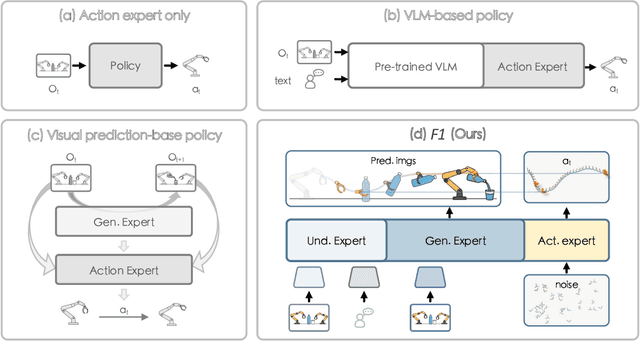

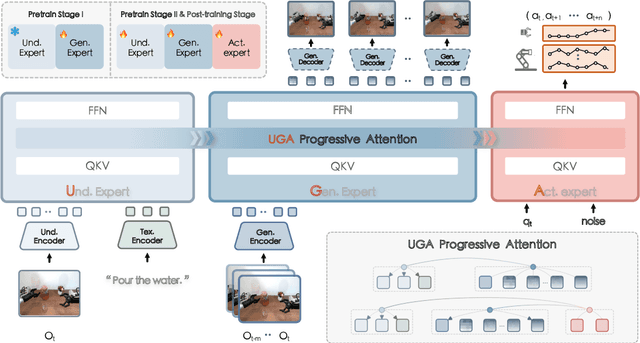

Abstract:Executing language-conditioned tasks in dynamic visual environments remains a central challenge in embodied AI. Existing Vision-Language-Action (VLA) models predominantly adopt reactive state-to-action mappings, often leading to short-sighted behaviors and poor robustness in dynamic scenes. In this paper, we introduce F1, a pretrained VLA framework which integrates the visual foresight generation into decision-making pipeline. F1 adopts a Mixture-of-Transformer architecture with dedicated modules for perception, foresight generation, and control, thereby bridging understanding, generation, and actions. At its core, F1 employs a next-scale prediction mechanism to synthesize goal-conditioned visual foresight as explicit planning targets. By forecasting plausible future visual states, F1 reformulates action generation as a foresight-guided inverse dynamics problem, enabling actions that implicitly achieve visual goals. To endow F1 with robust and generalizable capabilities, we propose a three-stage training recipe on an extensive dataset comprising over 330k trajectories across 136 diverse tasks. This training scheme enhances modular reasoning and equips the model with transferable visual foresight, which is critical for complex and dynamic environments. Extensive evaluations on real-world tasks and simulation benchmarks demonstrate F1 consistently outperforms existing approaches, achieving substantial gains in both task success rate and generalization ability.
Hunyuan-Game: Industrial-grade Intelligent Game Creation Model
May 20, 2025Abstract:Intelligent game creation represents a transformative advancement in game development, utilizing generative artificial intelligence to dynamically generate and enhance game content. Despite notable progress in generative models, the comprehensive synthesis of high-quality game assets, including both images and videos, remains a challenging frontier. To create high-fidelity game content that simultaneously aligns with player preferences and significantly boosts designer efficiency, we present Hunyuan-Game, an innovative project designed to revolutionize intelligent game production. Hunyuan-Game encompasses two primary branches: image generation and video generation. The image generation component is built upon a vast dataset comprising billions of game images, leading to the development of a group of customized image generation models tailored for game scenarios: (1) General Text-to-Image Generation. (2) Game Visual Effects Generation, involving text-to-effect and reference image-based game visual effect generation. (3) Transparent Image Generation for characters, scenes, and game visual effects. (4) Game Character Generation based on sketches, black-and-white images, and white models. The video generation component is built upon a comprehensive dataset of millions of game and anime videos, leading to the development of five core algorithmic models, each targeting critical pain points in game development and having robust adaptation to diverse game video scenarios: (1) Image-to-Video Generation. (2) 360 A/T Pose Avatar Video Synthesis. (3) Dynamic Illustration Generation. (4) Generative Video Super-Resolution. (5) Interactive Game Video Generation. These image and video generation models not only exhibit high-level aesthetic expression but also deeply integrate domain-specific knowledge, establishing a systematic understanding of diverse game and anime art styles.
HunyuanVideo: A Systematic Framework For Large Video Generative Models
Dec 03, 2024



Abstract:Recent advancements in video generation have significantly impacted daily life for both individuals and industries. However, the leading video generation models remain closed-source, resulting in a notable performance gap between industry capabilities and those available to the public. In this report, we introduce HunyuanVideo, an innovative open-source video foundation model that demonstrates performance in video generation comparable to, or even surpassing, that of leading closed-source models. HunyuanVideo encompasses a comprehensive framework that integrates several key elements, including data curation, advanced architectural design, progressive model scaling and training, and an efficient infrastructure tailored for large-scale model training and inference. As a result, we successfully trained a video generative model with over 13 billion parameters, making it the largest among all open-source models. We conducted extensive experiments and implemented a series of targeted designs to ensure high visual quality, motion dynamics, text-video alignment, and advanced filming techniques. According to evaluations by professionals, HunyuanVideo outperforms previous state-of-the-art models, including Runway Gen-3, Luma 1.6, and three top-performing Chinese video generative models. By releasing the code for the foundation model and its applications, we aim to bridge the gap between closed-source and open-source communities. This initiative will empower individuals within the community to experiment with their ideas, fostering a more dynamic and vibrant video generation ecosystem. The code is publicly available at https://github.com/Tencent/HunyuanVideo.
Global and Local Semantic Completion Learning for Vision-Language Pre-training
Jun 12, 2023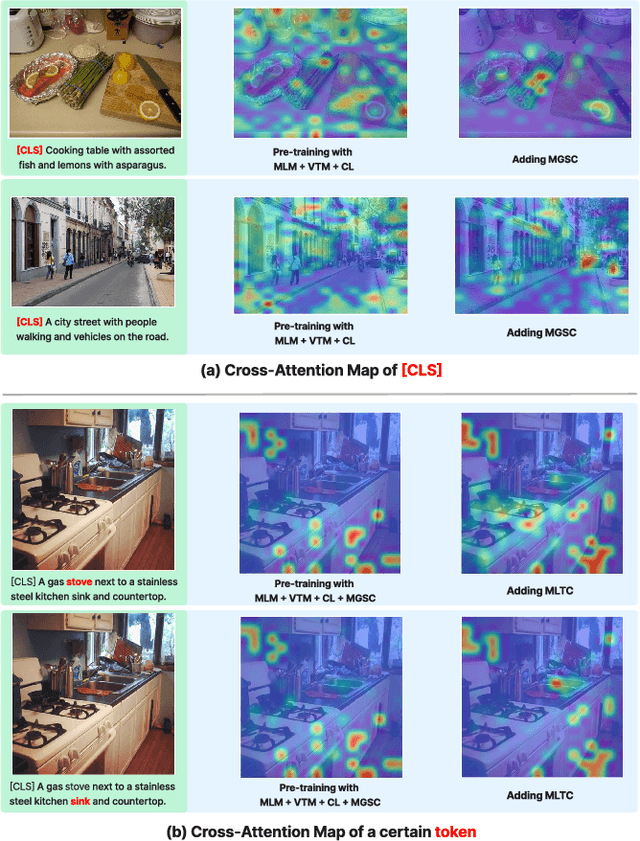
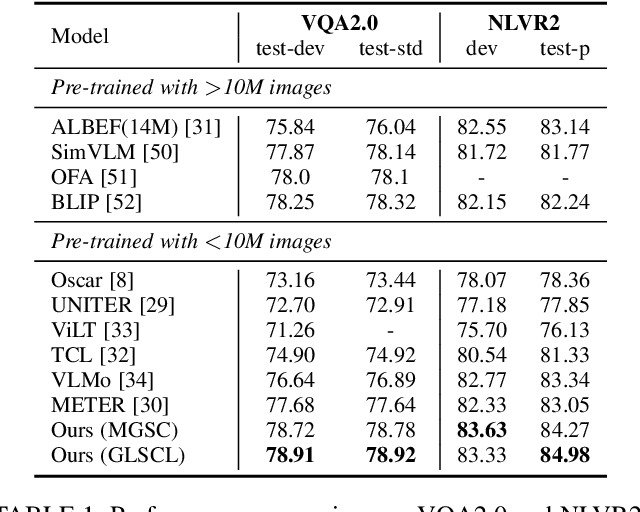

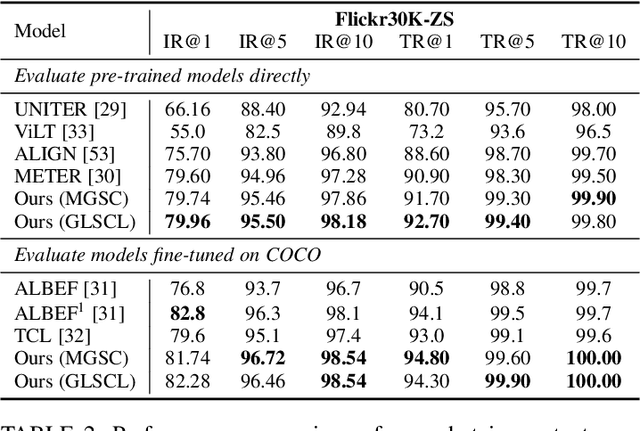
Abstract:Cross-modal alignment plays a crucial role in vision-language pre-training (VLP) models, enabling them to capture meaningful associations across different modalities. For this purpose, inspired by the success of masked language modeling (MLM) tasks in the NLP pre-training area, numerous masked modeling tasks have been proposed for VLP to further promote cross-modal interactions. The core idea of previous masked modeling tasks is to focus on reconstructing the masked tokens based on visible context for learning local-local alignment, i.e., associations between image patches and text tokens. However, most of them pay little attention to the global semantic features generated for the masked data, resulting in a limited cross-modal alignment ability of global representations to local features of the other modality. Therefore, in this paper, we propose a novel Global and Local Semantic Completion Learning (GLSCL) task to facilitate global-local alignment and local-local alignment simultaneously. Specifically, the GLSCL task complements the missing semantics of masked data and recovers global and local features by cross-modal interactions. Our GLSCL consists of masked global semantic completion (MGSC) and masked local token completion (MLTC). MGSC promotes learning more representative global features which have a great impact on the performance of downstream tasks, and MLTC can further enhance accurate comprehension on multimodal data. Moreover, we present a flexible vision encoder, enabling our model to simultaneously perform image-text and video-text multimodal tasks. Experimental results show that our proposed method obtains state-of-the-art performance on various vision-language benchmarks, such as visual question answering, image-text retrieval, and video-text retrieval.
Seeing What You Miss: Vision-Language Pre-training with Semantic Completion Learning
Nov 24, 2022Abstract:Cross-modal alignment is essential for vision-language pre-training (VLP) models to learn the correct corresponding information across different modalities. For this purpose, inspired by the success of masked language modeling (MLM) tasks in the NLP pre-training area, numerous masked modeling tasks have been proposed for VLP to further promote cross-modal interactions. The core idea of previous masked modeling tasks is to focus on reconstructing the masked tokens based on visible context for learning local-to-local alignment. However, most of them pay little attention to the global semantic features generated for the masked data, resulting in the limited cross-modal alignment ability of global representations. Therefore, in this paper, we propose a novel Semantic Completion Learning (SCL) task, complementary to existing masked modeling tasks, to facilitate global-to-local alignment. Specifically, the SCL task complements the missing semantics of masked data by capturing the corresponding information from the other modality, promoting learning more representative global features which have a great impact on the performance of downstream tasks. Moreover, we present a flexible vision encoder, which enables our model to perform image-text and video-text multimodal tasks simultaneously. Experimental results show that our proposed method obtains state-of-the-art performance on various vision-language benchmarks, such as visual question answering, image-text retrieval, and video-text retrieval.
Egocentric Video-Language Pretraining @ Ego4D Challenge 2022
Jul 04, 2022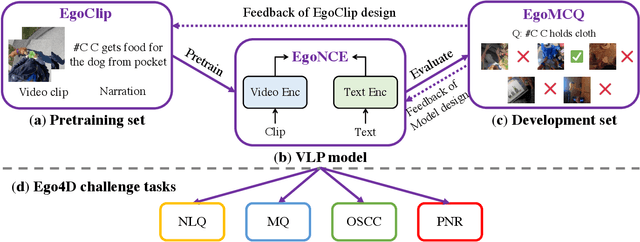
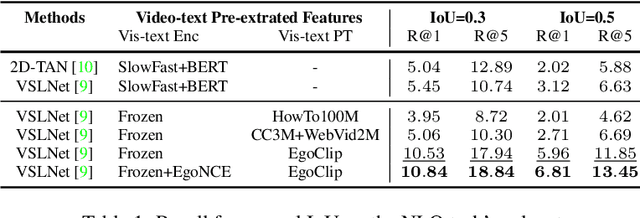

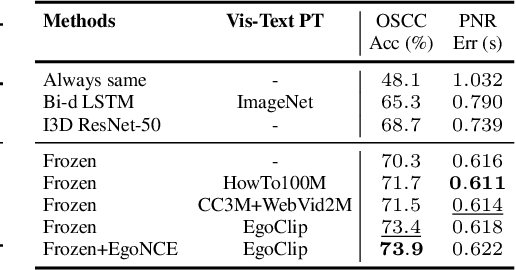
Abstract:In this report, we propose a video-language pretraining (VLP) based solution \cite{kevin2022egovlp} for four Ego4D challenge tasks, including Natural Language Query (NLQ), Moment Query (MQ), Object State Change Classification (OSCC), and PNR Localization (PNR). Especially, we exploit the recently released Ego4D dataset \cite{grauman2021ego4d} to pioneer Egocentric VLP from pretraining dataset, pretraining objective, and development set. Based on the above three designs, we develop a pretrained video-language model that is able to transfer its egocentric video-text representation or video-only representation to several video downstream tasks. Our Egocentric VLP achieves 10.46R@1&IoU @0.3 on NLQ, 10.33 mAP on MQ, 74% Acc on OSCC, 0.67 sec error on PNR. The code is available at https://github.com/showlab/EgoVLP.
Egocentric Video-Language Pretraining @ EPIC-KITCHENS-100 Multi-Instance Retrieval Challenge 2022
Jul 04, 2022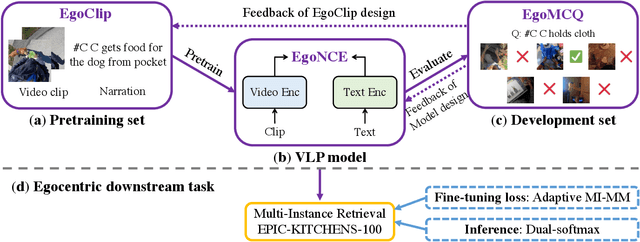
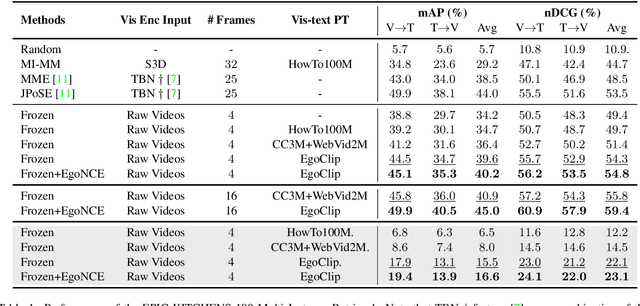
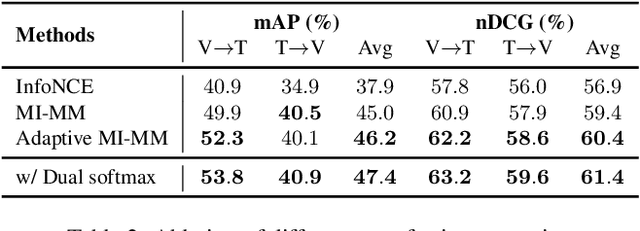
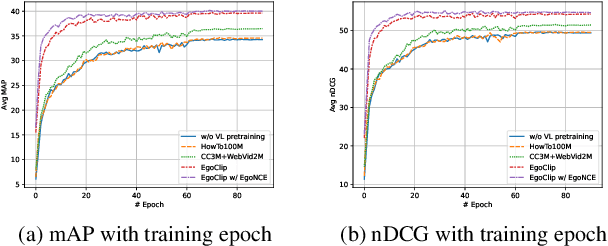
Abstract:In this report, we propose a video-language pretraining (VLP) based solution \cite{kevin2022egovlp} for the EPIC-KITCHENS-100 Multi-Instance Retrieval (MIR) challenge. Especially, we exploit the recently released Ego4D dataset \cite{grauman2021ego4d} to pioneer Egocentric VLP from pretraining dataset, pretraining objective, and development set. Based on the above three designs, we develop a pretrained video-language model that is able to transfer its egocentric video-text representation to MIR benchmark. Furthermore, we devise an adaptive multi-instance max-margin loss to effectively fine-tune the model and equip the dual-softmax technique for reliable inference. Our best single model obtains strong performance on the challenge test set with 47.39% mAP and 61.44% nDCG. The code is available at https://github.com/showlab/EgoVLP.
Egocentric Video-Language Pretraining
Jun 03, 2022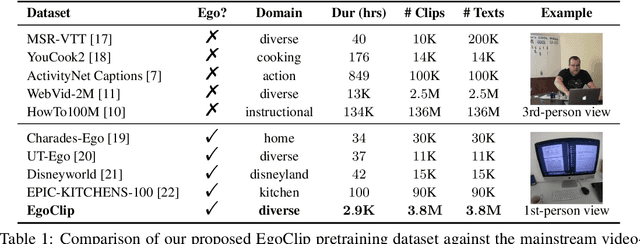
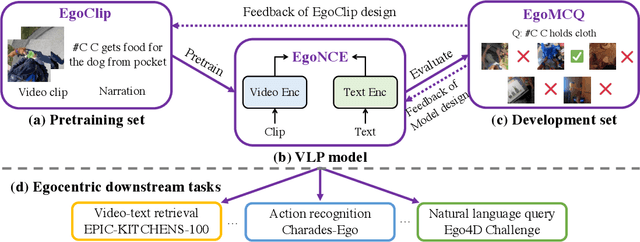
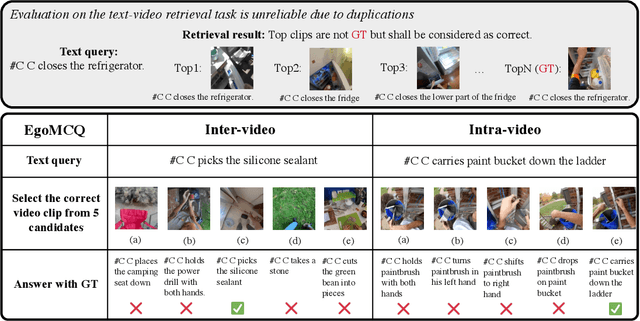

Abstract:Video-Language Pretraining (VLP), aiming to learn transferable representation to advance a wide range of video-text downstream tasks, has recently received increasing attention. Dominant works that achieve strong performance rely on large-scale, 3rd-person video-text datasets, such as HowTo100M. In this work, we exploit the recently released Ego4D dataset to pioneer Egocentric VLP along three directions. (i) We create EgoClip, a 1st-person video-text pretraining dataset comprising 3.8M clip-text pairs well-chosen from Ego4D, covering a large variety of human daily activities. (ii) We propose a novel pretraining objective, dubbed as EgoNCE, which adapts video-text contrastive learning to egocentric domain by mining egocentric-aware positive and negative samples. (iii) We introduce EgoMCQ, a development benchmark that is close to EgoClip and hence can support effective validation and fast exploration of our design decisions regarding EgoClip and EgoNCE. Furthermore, we demonstrate strong performance on five egocentric downstream tasks across three datasets: video-text retrieval on EPIC-KITCHENS-100; action recognition on Charades-Ego; and natural language query, moment query, and object state change classification on Ego4D challenge benchmarks. The dataset and code will be available at https://github.com/showlab/EgoVLP.
HunYuan_tvr for Text-Video Retrivial
Apr 14, 2022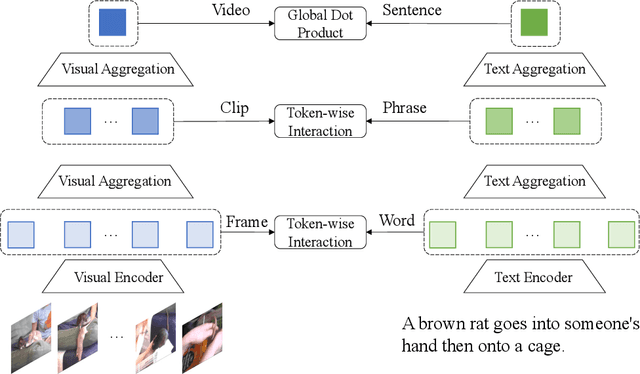

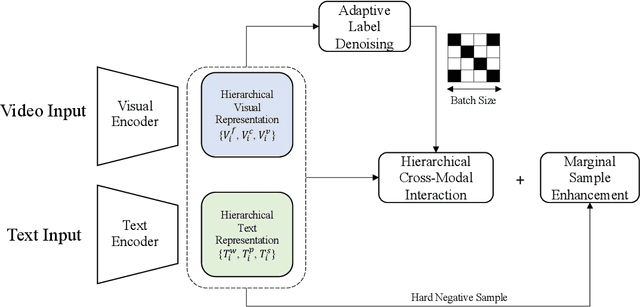
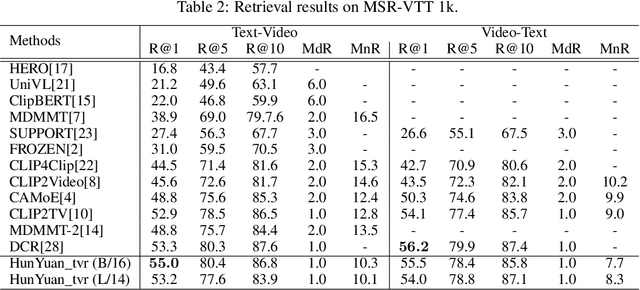
Abstract:Text-Video Retrieval plays an important role in multi-modal understanding and has attracted increasing attention in recent years. Most existing methods focus on constructing contrastive pairs between whole videos and complete caption sentences, while ignoring fine-grained cross-modal relationships, e.g., short clips and phrases or single frame and word. In this paper, we propose a novel method, named HunYuan\_tvr, to explore hierarchical cross-modal interactions by simultaneously exploring video-sentence, clip-phrase, and frame-word relationships. Considering intrinsic semantic relations between frames, HunYuan\_tvr first performs self-attention to explore frame-wise correlations and adaptively clusters correlated frames into clip-level representations. Then, the clip-wise correlation is explored to aggregate clip representations into a compact one to describe the video globally. In this way, we can construct hierarchical video representations for frame-clip-video granularities, and also explore word-wise correlations to form word-phrase-sentence embeddings for the text modality. Finally, hierarchical contrastive learning is designed to explore cross-modal relationships,~\emph{i.e.,} frame-word, clip-phrase, and video-sentence, which enables HunYuan\_tvr to achieve a comprehensive multi-modal understanding. Further boosted by adaptive label denosing and marginal sample enhancement, HunYuan\_tvr obtains new state-of-the-art results on various benchmarks, e.g., Rank@1 of 55.0%, 57.8%, 29.7%, 52.1%, and 57.3% on MSR-VTT, MSVD, LSMDC, DiDemo, and ActivityNet respectively.
Graph Convolutional Label Noise Cleaner: Train a Plug-and-play Action Classifier for Anomaly Detection
Mar 18, 2019

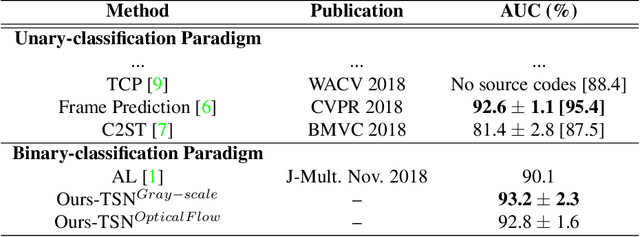

Abstract:Video anomaly detection under weak labels is formulated as a typical multiple-instance learning problem in previous works. In this paper, we provide a new perspective, i.e., a supervised learning task under noisy labels. In such a viewpoint, as long as cleaning away label noise, we can directly apply fully supervised action classifiers to weakly supervised anomaly detection, and take maximum advantage of these well-developed classifiers. For this purpose, we devise a graph convolutional network to correct noisy labels. Based upon feature similarity and temporal consistency, our network propagates supervisory signals from high-confidence snippets to low-confidence ones. In this manner, the network is capable of providing cleaned supervision for action classifiers. During the test phase, we only need to obtain snippet-wise predictions from the action classifier without any extra post-processing. Extensive experiments on 3 datasets at different scales with 2 types of action classifiers demonstrate the efficacy of our method. Remarkably, we obtain the frame-level AUC score of 82.12% on UCF-Crime.
 Add to Chrome
Add to Chrome Add to Firefox
Add to Firefox Add to Edge
Add to Edge